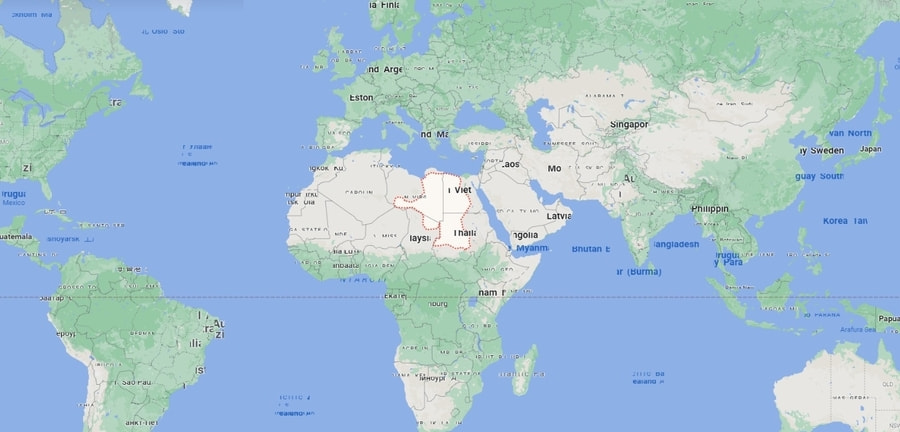The Sahara Desert is located in North Africa, stretching across several countries on the continent. Here are some details about the Sahara Desert's location.
Location Map of Sahara Desert, Western Sahara
 About Map: Map showing Where is Sahara Desert, Western Sahara located in the Map.
About Map: Map showing Where is Sahara Desert, Western Sahara located in the Map.
About Sahara Desert
The Sahara Desert is the largest hot desert in the world, located in North Africa. Here are some key facts about the Sahara Desert.Geographic Extent: The Sahara Desert spans across multiple countries in North Africa, including Algeria, Chad, Egypt, Libya, Mali, Mauritania, Morocco, Niger, Sudan, and Tunisia. It covers an area of approximately 9.2 million square kilometers (3.6 million square miles), making it similar in size to the entire United States or China.
Climate: The Sahara is characterized by an extremely arid climate, with little rainfall and high temperatures. It experiences scorching daytime temperatures, often exceeding 50°C (122°F), while nights can be cold due to low humidity. The desert's extreme conditions make it one of the most inhospitable places on Earth.
Landscape: The Sahara features diverse landscapes, including vast stretches of sand dunes, rocky plateaus, gravel plains, and mountains. The ergs (sand dunes) of the Sahara, such as those in the Erg Chebbi region of Morocco, are iconic and attract tourists.
Flora and Fauna: Despite its harsh conditions, the Sahara is home to some resilient plant and animal species. Vegetation is generally sparse, consisting of drought-resistant plants such as acacias, grasses, and shrubs. Desert-adapted animals, including camels, fennec foxes, scorpions, and various reptiles, have evolved to survive in the desert's extreme environment.
Cultural Significance: The Sahara has a rich cultural history and has been inhabited by various indigenous peoples, including the Tuareg, Berbers, and Bedouins. These nomadic and semi-nomadic groups have adapted their lifestyles to the desert, relying on camel herding and trade routes across the Sahara.
Economic Resources: The Sahara has significant mineral resources, including oil, natural gas, phosphates, and minerals such as uranium. Some countries, such as Algeria and Libya, have developed extraction industries to utilize these resources.
Tourism: The Sahara attracts tourists from around the world who seek to experience the desert's vastness, beauty, and unique cultures. Visitors often embark on camel treks, explore ancient caravan routes, or spend nights in desert camps under starry skies.
The Sahara Desert is an awe-inspiring and challenging environment that continues to captivate travelers and researchers with its vastness, harshness, and cultural heritage. It stands as a remarkable natural wonder of our planet.
World Travel Destinations
- 100 Wonders Of The World
- 7 Wonders Of World
- Where is Acropolis
- Where is Alhambra
- Where is Amalfi Coast
- Where is Amazon Rainforest
- Where is Angel Falls
- Where is Angkor Wat
- Where is Bali
- Where is Banaue Terraces
- Where is Bora Bora
- Where is Borobudur
- Where is Burj Khalifa
- Where is Cappadocia
- Where is Carlsbad Caverns
- Where is Chichen Itza
- Where is Colosseum Of Rome
- Where is Dubrovnik
- Where is Easter Island
- Where is Eiffel Tower
- Where is Fjords Of Norway
- Where is Galapagos Islands
- Where is Grand Canyon
- Where is Great Barrier Reef
- Where is Great Pyramid Of Giza
- Where is Great Wall Of China
- Where is Iguazu Falls
- Where is Konark Temple
- Where is Leaning Tower Pisa
- Where is Louvre Museum
- Where is Machu Picchu
- Where is Marrakesh
- Where is Matterhorn
- Where is Mecca
- Where is Mount Everest
- Where is Pagan Temples
- Where is Petra
- Where is Pompeii
- Where is Portofino
- Where is Potala Palace
- Where is Sahara Desert
- Where is Santorini
- Where is Sistine Chapel
- Where is Stonehenge
- Where is Suez Canel
- Where is Taj Mahal
- Where is Teotihuacan
- Where is Terracotta Warriors
- Where is Valley Of The Kings
- Where is Versailles
- Where is Victoria Falls
- Where is Mount Rushmore
- Where is Prague
- Where is Tunis
- Where is Curacao
- Where is Babylon
- Where is Death Valley
- Where is Tahiti
- Where is Oak Island
- Where is Mount Fuji
- Where is Timbuktu
- Where is Canary Islands
- Where is Monte Carlo
- Where is Atlantis
- Where is Dead Sea
- Where is Amalfi Coast
- Where is Kosovo
- Where is Great Barrier Reef
- Where is Panama Canal
- Where is The Red Sea
- Where is Aconcagua Mountain
- Where is Azores
- Where is Devil'S Tower
- Where is Antwerp
- Where is The Faroe Islands
- Where is Santorini
- Where is Kilimanjaro
- Where is Banff National Park
- Where is Mount Olympus
- Where is Ninevah
- Where is Mount Etna
- Where is Deadwood
- Where is Lake Titicaca
- Where is Yucatan Peninsula
- Where is Mount Mckinley
- Where is Angel Falls
- Where is The Blue Lagoon
- Where is Petrified Forest
- Where is Rock Of Gibraltar
- Where is Glass Beach
- Where is Atacama Desert
- Where is Mount Ararat
- Where is Falkland Islands
- Where is Channel Islands
- Where is Badlands National Park
- Where is Tree Of Life
- Where is Dubrovnik
- Where is Loch Ness
